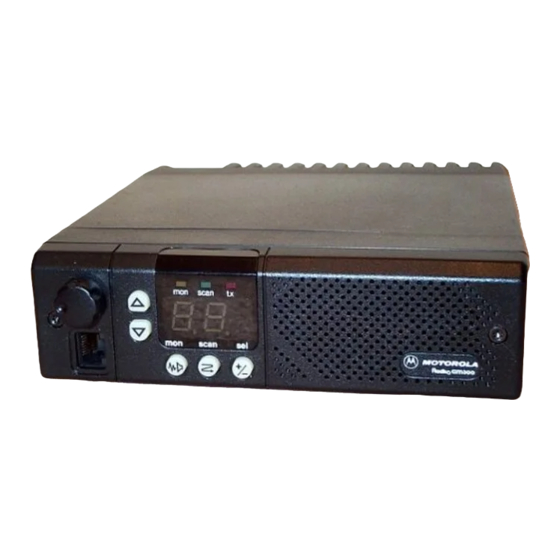Motorola RADIUS GM300 Servis Kılavuzu - Sayfa 38
Radyo Motorola RADIUS GM300 için çevrimiçi göz atın veya pdf Servis Kılavuzu indirin. Motorola RADIUS GM300 49 sayfaları. 16-channel, conventional fm radio
Ayrıca Motorola RADIUS GM300 için: Servis Kılavuzu (28 sayfalar), Kullanım Talimatları Kılavuzu (18 sayfalar), Kullanım Talimatları Kılavuzu (19 sayfalar), Kullanıcı Kılavuzu (37 sayfalar), Kullanım Talimatları (2 sayfalar)

Name of Manual
with the internal ÒonÓ inductance of CR2751, form a
series resonant circuit to lower the shunt impedance
presented by CR2751 when it is conducting.
In the receive mode, both diodes are off. Signals
applied at the antenna jack J1 are routed, via the har-
monic Þlter, through network L2751, C2752 and C2753
to the receiver input. In the transmit mode, 9.6T is
present and both diodes are forward-biased into con-
duction. The transmitter RF from Q2740 is routed
through CR2750, and via the harmonic Þlter to the
antenna jack. CR2751 conducts, shunting RF power
and preventing it from reaching the receiver. L2751 is
selected to appear as a 1/4 wave at the appropriate
operating frequency range so that the low impedance
of CR2751 appears as a high impedance at the junction
of CR2750 and the harmonic Þlter input.
The harmonic Þlters are seven pole low pass designs
having either a 0.1 dB ripple Chebychev response (403-
433 MHz and 438-470 MHz bands) or a Butterworth
response (465-495 and 490-520 MHz). They are charac-
terized as follows:
Range
403-433
438-470
f(-3 dB):
520 MHz
510 MHz
Loss:
0.8 dB
Front Panel Boards
The front panel housing itself contains two circuit
boards, the Display Board and the Volume/Mic Board.
There are two different types of Display Boards,
depending on model. In 2-frequency models, discrete
LEDÕs provide channel indication. In 8 or 16 frequency
models, seven-segment LED displays are used.
A third board, the Front Panel Filter Board, is located
on the front of the radio chassis.
Display Board
The 2-Frequency Display Board consists of four dis-
crete LEDÕs. Two are dual color type. They indicate
channel 1 or 2, and turn from green to red when the
radio is in the transmit mode.
The logic board provides the following control signals:
TX/BUSY (P9-1) is ßoating in RX mode, and active low
in TX mode; FPE (P9-4) supplies 5V via 10k for F2, and
0V via 10k for F1. This allows four display conditions,
as follows:
¥ F1 RECEIVE: P9-4 is low, therefore Q1003 is off
(DS1002 cannot light) and Q1001 is on (DS1001
cathodes are grounded). In receive, P9-1 ßoats,
causing DS1001 GRN to light via R1003, and
Q1002 is saturated, shorting out DS1001 RED so
it doesnÕt light.
March, 1997
465-495
490-520
620 MHz
650 MHz
0.8 dB
0.8 dB
0.8 dB
¥ F1 TRANSMIT: P9-4 is low, therefore Q1003 is
off (DS1002 cannot light) and Q1001 is on
(DS1001 cathodes are grounded). In transmit,
P9-1 is active low, turning off Q1002 and allow-
ing DS1001 RED to light via R1004. Also, since
P9-1 is low, DS1001 GRN is shorted out and can-
not light.
¥ F2 RECEIVE: P9-4 is high via 10k, therefore
Q1003 is saturated, grounding the cathodes of
DS1002 and turning off Q1001. Since Q1001 is
off, DS1001 cannot light. In receive, P9-1 ßoats,
causing DS1002 GRN to light via R1003, and
Q1002 is saturated, shorting out DS1002 RED so
it doesnÕt light.
¥ F2 TRANSMIT: P9-4 is high via 10k, therefore
Q1003 is saturated, grounding the cathodes of
DS1002 and turning off Q1001. Since Q1001 is
off, DS1001 cannot light. In transmit, P9-1 is
active low, turning off Q1002 and allowing
DS1002 RED to light via R1004. Also, since P9-1
is low, DS1002 GRN is shorted out and cannot
light.
DS1004 (Monitor) lights when Q1004 is satu-
rated by 5V via 10k applied to FPD (P9-3).
DS1004 (Busy) lights when Q1005 is saturated
by 5V via 10k applied to FPC (P9-6).
SW1001 (Mode) and SW1002 (Monitor) are nor-
mally-open pushbuttons which provide a low to
FPA (P9-7) and FPB (P9-5) respectively.
Display Board (8/16 Freq Models)
The 8/16 Frequency Display Board consists of three
colored indicator LEDÕs (DS1101-3), three green LEDÕs
which illuminate the keypad buttons (DS1105-7), a
dual 7-segment LED display (DS1104), a display driver
IC (U1101) and Þve momentary pushbuttons (SW1101-
5).
After power up, the microcomputer loads U1101 with
information using the SERIAL DATA (P9-10), SERIAL
CLOCK (P9-11), and DISPLAY ENABLE (P9-2) lines.
This data tells U1101 which segments and indicator
LEDÕs to illuminate. U1101 is a shift register latch. Its
outputs are active low when a particular LED is to be
illuminated, or open circuit when an LED is to remain
off. The anodes of all LED indicators or segments are
connected to the +5V DC source. The three keypad illu-
mination LEDÕs are lit at all times when +5V is present.
SW1101 through SW1105 are normally-open momen-
tary pushbuttons. When pressed, the conductive ink
on the back side of the rubber pushbutton comes in
contact with the exposed circuit pattern on the display
circuit board, providing a low resistance (less than 100
ohms) path to ground.
68 No.
Theory of Operation
Front Panel Boards
2-13
